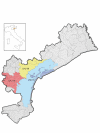Sarcoma risk and dioxin emissions from incinerators and industrial plants: a population-based case-control study (Italy)
- PMID: 17634118
- PMCID: PMC1948886
- DOI: 10.1186/1476-069X-6-19
Sarcoma risk and dioxin emissions from incinerators and industrial plants: a population-based case-control study (Italy)
Abstract
Background: It is not clear whether environmental exposure to dioxin affects the general population. The aim of this research is to evaluate sarcoma risk in relation to the environmental pollution caused by dioxin emitted by waste incinerators and industrial sources of airborne dioxin. The study population lives in a part of the Province of Venice (Italy), where a population-based cancer registry (Veneto Tumour Registry--RTV) has been active since 1987.
Methods: Two hundred and five cases of visceral and extravisceral sarcoma, confirmed by microscopic examination, diagnosed from 01.01.1990 to 31.12.1996, were extracted from the RTV database. Diagnoses were revised using the actual pathology reports and clinical records. For each sarcoma case, three controls of the same age and sex were randomly selected from the population files of the Local Health Units (LHUs). The residential history of each subject, whether case or control, was reconstructed, address by address, from 1960 to the date of diagnosis. All waste incinerators and industrial sources of airborne dioxin in the Province of Venice were taken into account, as was one very large municipal waste incinerator outside the area but close to its boundaries. The Industrial Source Complex Model in Long Term mode, version 3 (ISCLT3), was used to assess the level of atmospheric dispersion. A specific value for exposure was calculated for each point (geo-referenced address) and for each calendar year; the exposure value for each subject is expressed as the average of specific time-weighted values. The analysis takes into account 172 cases and 405 controls, aged more than 14 years.
Results: The risk of developing a sarcoma is 3.3 times higher (95% Confidence Interval--95% CI: 1.24-8.76) among subjects, both sexes, with the longest exposure period and the highest exposure level ; a significant excess of risk was also observed in women (Odds Ratio OR = 2.41, 95% CI: 1.04-5.59) and for cancers of the connective and other soft tissue (International Classification of Diseases, ninth Revision--ICD-IX 171), both sexes (OR = 3.27, 95% CI: 1.35-7.93).
Conclusion: Our study supports the association between modelled dioxin exposure and sarcoma risk.
Figures
Similar articles
-
Residential proximity to an industrial incinerator and risk of soft-tissue sarcoma, 1999-2014.Epidemiol Prev. 2020 Mar-Jun;44(2-3):128-136. doi: 10.19191/EP20.2-3.P128.035. Epidemiol Prev. 2020. PMID: 32631012 English.
-
[Dioxin emissions and soft-tissue sarcoma: results of a population-based case-control study].Rev Epidemiol Sante Publique. 2004 Jun;52(3):213-20. doi: 10.1016/s0398-7620(04)99047-5. Rev Epidemiol Sante Publique. 2004. PMID: 15356435 French.
-
[Environmental pollution from dioxins and soft tissue sarcomas in the population of Venice and Mestre: an example of the use of current electronic information sources].Epidemiol Prev. 2006 May-Jun;30(3):191-8. Epidemiol Prev. 2006. PMID: 17051943 Italian.
-
Dioxin formation from waste incineration.Rev Environ Contam Toxicol. 2007;190:1-41. doi: 10.1007/978-0-387-36903-7_1. Rev Environ Contam Toxicol. 2007. PMID: 17432330 Review.
-
[SENTIERI - Epidemiological Study of Residents in National Priority Contaminated Sites. Sixth Report].Epidemiol Prev. 2023 Jan-Apr;47(1-2 Suppl 1):1-286. doi: 10.19191/EP23.1-2-S1.003. Epidemiol Prev. 2023. PMID: 36825373 Italian.
Cited by
-
Linking Environmental Hazards to Osteosarcoma Development: A Comprehensive Review.Cancer Manag Res. 2025 Aug 21;17:1725-1739. doi: 10.2147/CMAR.S542371. eCollection 2025. Cancer Manag Res. 2025. PMID: 40861075 Free PMC article. Review.
-
A review of the epidemiological methods used to investigate the health impacts of air pollution around major industrial areas.J Environ Public Health. 2013;2013:737926. doi: 10.1155/2013/737926. Epub 2013 Jun 2. J Environ Public Health. 2013. PMID: 23818910 Free PMC article. Review.
-
Plasma levels of polychlorinated biphenyls (PCB) and the risk of soft tissue sarcoma.Med Lav. 2019 Oct 29;110(5):342-352. doi: 10.23749/mdl.v110i5.8490. Med Lav. 2019. PMID: 31659991 Free PMC article.
-
Development and performance evaluation of a GIS-based metric to assess exposure to airborne pollutant emissions from industrial sources.Environ Health. 2019 Jan 25;18(1):8. doi: 10.1186/s12940-019-0446-x. Environ Health. 2019. PMID: 30683108 Free PMC article.
-
Association between dioxin and cancer incidence and mortality: a meta-analysis.Sci Rep. 2016 Nov 29;6:38012. doi: 10.1038/srep38012. Sci Rep. 2016. PMID: 27897234 Free PMC article.
References
-
- Environmental Protection Agency The exposure and Human Health Reassessment of 2,3,7,8-Tetrachlorodibenzo-p -dioxin (TCDD) and Related Compound (EPA) 2003a, Part I; 2003b, Part II; 2003c, Part III. http://www.epa.gov/ncea/pdfs/dioxin/nas-review/#part1; http://www.epa.go... accessed 6th March 2007.
-
- National Research Council . Health risks from dioxin and related compounds Evaluation of the EPA Reassessment. Washington DC: The National Academies Press; 2006. pp. 1–239.
Publication types
MeSH terms
Substances
LinkOut - more resources
Full Text Sources
Medical



